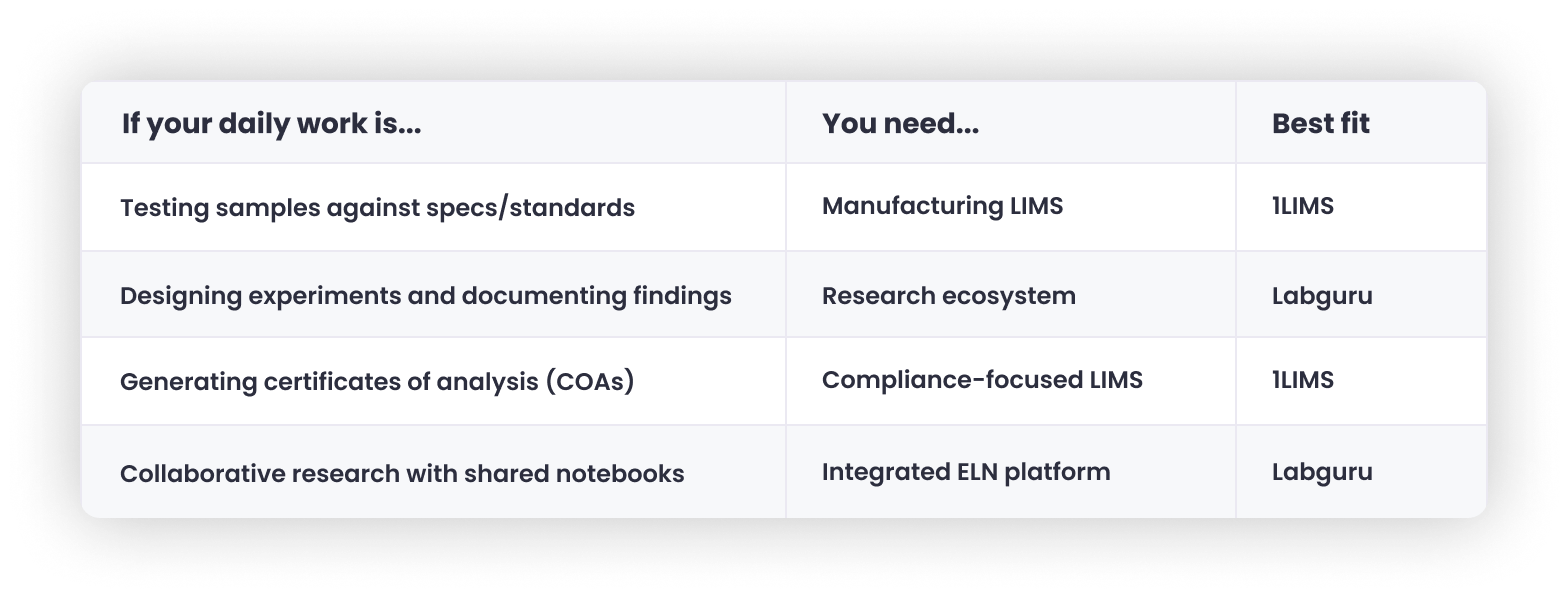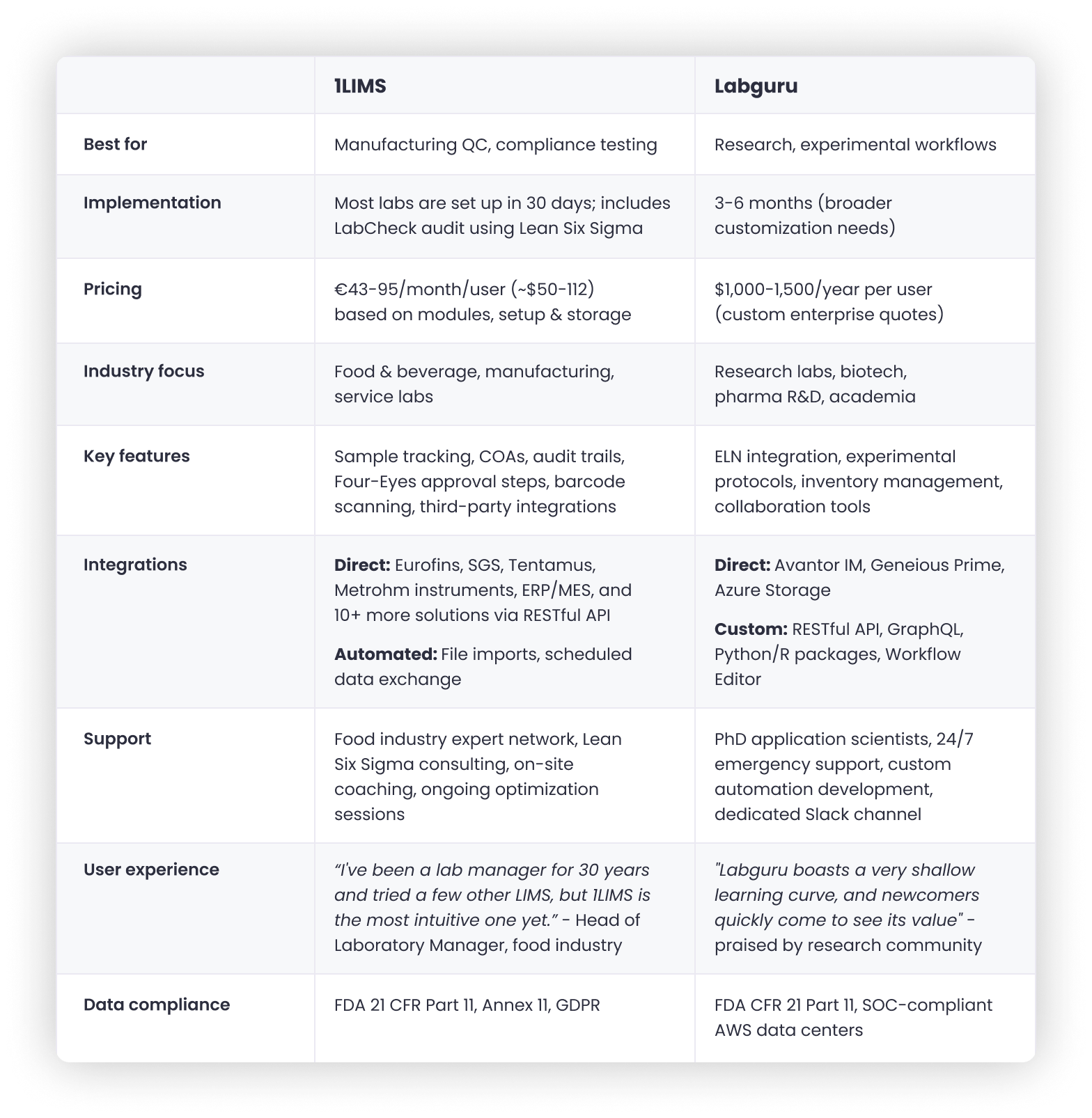Help shape the 2025 Lab Efficiency Report!
Take the survey now.
1LIMS and Labguru rarely compete because we solve different problems. 1LIMS handles manufacturing workflows, while Labguru manages research data. Understanding this difference will save you months of evaluation time. Below, we explain exactly when each platform works best, including scenarios where 1LIMS and Labguru are clearly the better choice.

Most LIMS comparisons miss the point. They compare features when they should compare use cases. That’s the case with 1LIMS vs Labguru. Most labs shouldn't be comparing us at all because we serve completely different markets.
Since you're here, let's break down when each platform makes sense. We're obviously biased toward our platform, but we'd rather you pick the right solution (even if it's not ours) than struggle with the wrong one.
Most labs categorize themselves by industry ("we're a food lab") when they should also consider workflow. It’s essential to understand your lab's specific requirements and lab processes when choosing a LIMS, as selecting a system tailored to your unique workflows ensures better support for growth, compliance, and efficiency.
For example, a pharmaceutical company might need manufacturing QC tools for batch testing or research platforms for drug development. Here are general guidelines for when your lab might need 1LIMS or Labguru based on the workflow.

Some real-world scenario examples for when to choose 1LIMS and Labguru include:
If your lab doesn’t fit neatly into one category, apply the 80/20 rule, focusing on where you spend most of your time.
Take Polygal AG, a Swiss hydrocolloids manufacturer serving 55+ countries. They do both product development research and routine quality control testing. But since most of their lab work involves compliance testing for food, pharmaceutical, and cosmetic standards, they chose 1LIMS for manufacturing workflows. The result? They complete trend analysis "in minutes" instead of hours with Excel, and expanded 1LIMS to laboratories in Spain, Pakistan, and China.
Compare this to INSERM, France's national health research institute. They also do both research and routine testing across 300 researchers in multiple fields. But since most of their work involves experimental research and publication, they chose Labguru's research ecosystem. Result: 60% of researchers now use it daily, with significantly improved experimental traceability and knowledge preservation.
Most labs think they need "everything" when they really need one primary system that excels at their main workflow. Here’s where 1LIMS and Labguru excel at.

A few areas where the difference between 1LIMS and Labguru is most stark:
The implementation timeline. 1LIMS gets most labs running in 30 days because we focus on manufacturing workflows that follow predictable patterns. Labguru takes several months on average because research environments need extensive customization for variable experimental protocols.
Read also: How to integrate LIMS with your laboratory in 30 days
The pricing models. Our transparent €43-95/month pricing works because manufacturing QC has standardized requirements. Labguru's custom enterprise quotes make sense for research labs where every implementation is unique.
The integrations show different workflows. Manufacturing labs need to connect their LIMS to ERP systems for production data, laboratory instruments for automated data transfer, and external service labs like Eurofins and SGS for specialized testing. 1LIMS provides direct connections with them. Meanwhile, research labs analyze data with Python and R, so Labguru provides APIs and packages that let scientists connect their statistical tools directly to their lab data, alongside other direct integrations.
Inventory management is at the heart of any effective laboratory information management system. Whether you’re tracking thousands of samples for quality control or managing a diverse array of reagents for experimental research, the right LIMS software can make or break your lab’s operations.
1LIMS: For manufacturing and QC labs, 1LIMS is designed to streamline inventory management by tightly integrating sample tracking, reagent usage, and supply levels into your routine laboratory processes. Every sample, batch, and consumable is assigned a unique identifier – often with barcode scanning – so you always know exactly where your materials are, how much you have on hand, and when you need to reorder. This approach minimizes manual data entry, reduces human error, and ensures data integrity across your entire workflow. Automated alerts for low stock, expiry dates, and usage trends help lab managers maintain compliance and avoid costly delays.
Because 1LIMS is built for standardized, repetitive testing, its inventory management features are optimized for speed, accuracy, and regulatory compliance, making it ideal for labs where missing a sample or running out of a critical reagent can halt production.
Labguru: In contrast, Labguru’s inventory management is tailored for research environments where flexibility and collaboration are key. Labguru combines sample management, reagent tracking, and equipment monitoring within its electronic lab notebook ecosystem, allowing researchers to link inventory items directly to experiments, protocols, and results. This means you can trace every sample or reagent back to its source, see how it was used in different projects, and ensure reproducibility across your research.
Labguru’s intuitive interface supports complex inventory hierarchies, such as freezers, shelves, and boxes, making it easy for lab personnel to locate and share resources, even across multiple sites. Integration with data analytics tools and automated audit trails further enhance data quality and security, supporting both day-to-day lab operations and long-term knowledge preservation.
1LIMS is good for labs whose primary focus is routine testing, compliance, and quality control operations. If you're testing samples against specifications rather than designing experiments, our manufacturing-focused LIMS will serve you better than research-oriented platforms like Labguru.
Here are three types of labs consistently choosing our platform.
Use case: Quality control testing for food safety compliance and batch release
Example: Zweifel Chips & Snacks AG, Switzerland's market leader in chips and snacks, solved their biggest quality control problem: lost samples. Before 1LIMS, they managed QC using "a combination of paper records and multiple Excel spreadsheets" that resulted in frequent sample losses and scattered data. With 1LIMS, they can quickly scan every sample in the lab with unique identification labels.
Use case: Routine testing against specifications with regulatory compliance requirements
Example: Take Frifag Märwil AG, a Swiss producer of high-quality poultry meat. Our signature LabCheck workshop revealed they were spending way too much time on quality management paperwork (32% per QA employee). We projected that 1LIMS could cut that down to just 10%, which would mean CHF 15,400 in annual savings with a 71% return on investment by replacing manual Excel work with automated processes.
Use case: Testing packaging materials for quality specifications and documentation
Example: Manufacturing labs across diverse industries face similar data management challenges. Model AG, a Swiss packaging manufacturer processing 1,040 samples yearly, exemplifies this pattern. Their 2-person laboratory was spending 49 hours per week on manual data management using Microsoft Access databases, Excel spreadsheets, paper forms, and scanned PDFs across different systems.

Our LabCheck assessment revealed they could cut their workload by 50% with centralized digital processes, which shows why materials testing labs consistently choose focused LIMS solutions.
1LIMS focuses on manufacturing workflows with compliance-first design, not the iterative, collaborative nature of research work.
When would research labs choose us? They usually don't. Contract testing labs serving multiple industries might consider 1LIMS because they perform routine analyses on diverse samples. But if your primary work involves method development, experimental protocols, or research documentation, Labguru's research ecosystem will serve you better.
Labguru shines when your lab's primary focus is: experimental research, method development, and collaborative projects. If you're designing experiments rather than following standardized testing procedures, Labguru's research-focused LIMS with integrated electronic lab notebook features will serve you better than our manufacturing-focused approach.
Here are three types of labs using Labguru most often.
Use case: Experimental research with collaborative lab notebooks and data sharing
Example: The University of Georgia's Professor B. Kvitko knew that "paper lab notebooks are virtually useless outside of the hands of the person who wrote it" – a major problem as students graduate and institutional knowledge is lost. With Labguru, Kvitko estimates that researchers can find experimental information "at least twice as fast as they could with their own paper notebooks, and 5 times as fast as they could with the notebooks of previous lab members." This saves each team member around 2 hours per week – time that adds up quickly across research teams.
Use case: Drug discovery research with experimental protocols and compound tracking
Example: Cerevance, a neuroscience biotech working on Alzheimer's and Parkinson's treatments, was stuck with paper workflows that made collaboration difficult and couldn't provide the audit trails needed to protect their intellectual property. After switching to Labguru, they gained back 75% of the time previously spent managing lab notebooks. Senior Group Leader Dino Ossola estimates his team now saves 45 minutes on every hour they spend updating lab notebooks.
More importantly, Labguru's experimental tracking helped them stay productive during COVID-19 restrictions when scientists had to work in shifts.
Use case: Multi-site biological reagent management and research collaboration
Example: AstraZeneca's Discovery Sciences Unit needed to manage biological reagents across multiple global research sites while migrating 15 years of legacy data. David Nicholls, the unit's Enabling Capabilities Manager, called it "the fastest IT implementation I have ever been personally involved in." The unified system now makes bio-reagent information accessible globally across their research network.
Labguru integrates LIMS software, ELN, and advanced informatics capabilities, not the compliance-first design and audit trails that manufacturing LIMS prioritize.
The bottom line: if your lab's value comes from discovery, experimentation, and pushing scientific boundaries forward, Labguru's research ecosystem will support your workflows better than any manufacturing-focused LIMS. We're good at what we do at 1LIMS, but we're not built for the iterative, collaborative nature of research work.
Most labs think the challenge is choosing between different platforms. But the real mistake is spending months evaluating solutions in the wrong category entirely.
You already know that manufacturing labs doing routine testing don't need research collaboration features. Research teams don't need manufacturing compliance workflows.
Here's what we recommend doing next:
For manufacturing/QC labs: Take our free and quick LabCheck assessment to see exactly where you're losing efficiency. We'll show you the specific time and cost savings possible in your lab. Or book a demo with our team if you'd prefer to see 1LIMS in action right away – we’ll be happy to show you our platform.
For research labs: Contact Labguru directly and ask about their pilot programs. Their PhD-level support team can quickly show you how their ELN integration works with your experimental workflows.
The choice isn't between 1LIMS and Labguru. It's between spending the next six months evaluating the wrong solutions or getting the right foundation implemented in the next 30-90 days. We’re sure you’ll find the right fit.